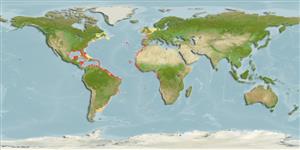Environment: milieu / climate zone / depth range / distribution range
Ecologia
marinhas; Água doce; estuarina associadas(os) a recifes; anfídromo (Ref. 51243); intervalo de profundidade 0 - 40 m (Ref. 3789), usually 0 - 15 m (Ref. 42064). Subtropical; 10°C - 40°C (Ref. 93687); 49°N - 44°S, 99°W - 14°E (Ref. 55254)
Atlantic Ocean: from Nova Scotia, Bermuda and southward to Brazil in western Atlantic Ocean (Ref. 3234, 4446), where it it also found throughout the Gulf of Mexico and the Caribbean (Ref. 26938); from Mauritania to Angola in eastern Atlantic Ocean (Ref. 2845, 3234, 4446, 81266); with exceptional records in Portugal, Azores and Atlantic coast of southern France (Ref. 3234, 4446). Crossed the Panama canal and was caught at Coiba Island in the Pacific Ocean (Ref. 4446).
Comprimento de primeira maturação / Tamanho / Peso / Idade
Maturity: Lm 160.0, range 130 - 128.5 cm
Max length : 250 cm TL macho/indeterminado; (Ref. 2683); common length : 130 cm TL macho/indeterminado; (Ref. 2683); peso máx. publicado: 161.0 kg (Ref. 26340); idade máx. registrada: 55 anos (Ref. 9975)
Espinhos dorsais (total): 0; Raios dorsais (total): 13-16; Espinhos anais 0; Raios anais : 22 - 25; Vértebras: 53 - 57. Diagnosis: It is characterized by the anterior position of pelvic fin insertions in relation to dorsal-fin origin, and by some morphometric counts: 13-16 dorsal-fin rays, 40-48 lateral-line scales and 53-57 vertebrae (Ref. 2845, 81266).
Obligate air-breathing (Ref. 126274); Inhabit coastal waters, bays, estuaries, mangrove-lined lagoons, and rivers (Ref. 3789, 27188). Often found in river mouths and bays, entering fresh water (Ref. 27227). Lower depth limit at 40m (Ref. 118621). Large schools may frequent particular spots for years (Ref. 9710). Feed on fishes like sardines, anchovies, Mugilidae, Centropomus, Cichlidae (mainly those forming schools) and crabs (Ref. 3789, 27188). The swim bladder, attached to the esophagus, can be filled directly with air and permits the fish to live in oxygen-poor waters. Has high fecundity, a 203 cm female is estimated to produce over 12 million eggs (Ref. 10863). Spawn in waters which can be temporarily isolated from the open sea (Ref. 27188). Transparent leptocephalus larvae migrate into estuaries (Ref. 57533). Famous for its spectacular leaps when hooked. Marketed fresh or salted (Ref. 3789). Large scales are used in ornamental work and in preparation of artificial pearls (Ref. 3789). Used to be cultured commercially in Colombia (Ref. 7306). Highly appreciated by sport fishers. The flesh is also highly appreciated despite its being bony (Ref. 27188). The world record for hook and line is 283 lbs. from Lake Maricaibo, Venezuela (Ref. 13442).
Some populations may complete life cycle in freshwater, e.g. Lake Nicaragua in Central America, and Deep Lake in Florida (Ref. 4639).
Hureau, J.-C., 1984. Megalopidae. p. 226-227. In P.J.P. Whitehead, M.-L. Bauchot, J.-C. Hureau, J. Nielsen and E. Tortonese (eds.) Fishes of the north-eastern Atlantic and Mediterranean. UNESCO, Paris. Vol. 1. (Ref. 3234)
Status na Lista Vermelha da UICN (Ref. 130435)
Ameaça para os humanos
Reports of ciguatera poisoning (Ref. 31172)
Uso pelos humanos
Pescarias: espécies comerciais; Aquacultura: espécies comerciais; peixe esportivo: sim; Aquário: Aquários públicos
Ferramentas
Relatórios especiais
Baixar XML
Fontes da internet
Estimates based on models
Preferred temperature (Ref.
123201): 19.6 - 28, mean 27 °C (based on 1409 cells).
Índice de diversidade filogenética (Ref.
82804): PD
50 = 1.0020 [Uniqueness, from 0.5 = low to 2.0 = high].
Bayesian length-weight: a=0.01023 (0.00419 - 0.02501), b=3.02 (2.81 - 3.23), in cm total length, based on LWR estimates for this (Sub)family-body shape (Ref.
93245).
Nível Trófico (Ref.
69278): 4.5 ±0.0 se; based on diet studies.
Resiliência (Ref.
120179): Baixo, tempo mínimo de duplicação da população 4,5 - 14 anos (K=0.07-0.10; tmax=55; Fec>1 million).
Prior r = 0.34, 95% CL = 0.21 - 0.55, Based on 1 stock assessment.
Fishing Vulnerability (Ref.
59153): Very high vulnerability (76 of 100).
Climate Vulnerability (Ref.
125649): High to very high vulnerability (67 of 100).
Nutrients (Ref.
124155): Calcium = 8.83 [4.70, 21.29] mg/100g; Iron = 0.421 [0.226, 0.795] mg/100g; Protein = 19.5 [16.7, 22.0] %; Omega3 = 0.21 [0.11, 0.40] g/100g; Selenium = 21.2 [9.5, 44.3] μg/100g; VitaminA = 33 [9, 118] μg/100g; Zinc = 0.458 [0.310, 0.701] mg/100g (wet weight);
